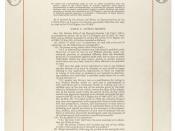"Title VII of the 1964 Civil Rights Act provides two primary theories of recovery for individuals; these are disparate treatment and disparate impact" (Bennett-Alexander & Hartman, 2007). Disparate treatment exists if an employer gives less favorable treatment to employees because of their race, color, religion, sex, or national origin. On the other hand, "disparate impact is the discrimination caused by policies that apply to everyone and seem neutral but have the effect of disadvantaging a protected group" (Bennett-Alexander & Hartman, 2007). Such policies are illegal unless they are strongly job-related and crucial to conduct the business. Basically, the intention of Title VII was to create a level playing field by prohibiting all discrimination.
Disparate Treatment: Coleman v. School Bd. of Richland ParishIn this case, Mrs. Coleman, an African-American woman, was hired as the associate principal at an elementary school in September 2000. The school board in October 2000 asked Mrs.
Coleman to resign. ÃÂWhen she refused to resign, the school held a hearing to consider nine charges of insubordination against herÃÂ (NSBA, 2005). The board found her guilty of four charges and terminated her employment. Mrs. Coleman brought suit against the board, alleging that white school board members created the associate principal position as a "concession" so that African-Americans would campaign for a school bond proposal in the African-American community.
According to Coleman, ÃÂthe day after the bond proposal passed she was asked by the school superintendent to resign (NSBA, 2005). When she refused to resign, the board allegedly threatened to "ruin her career" and began to write her up for false work violations. In her complaint, ÃÂthe woman alleged racial discrimination in violation of Title VII of the Civil Rights Act as well as state law causes of action of breach of contract and abuse of rightsÃÂ (NSBA, 2005)The...


